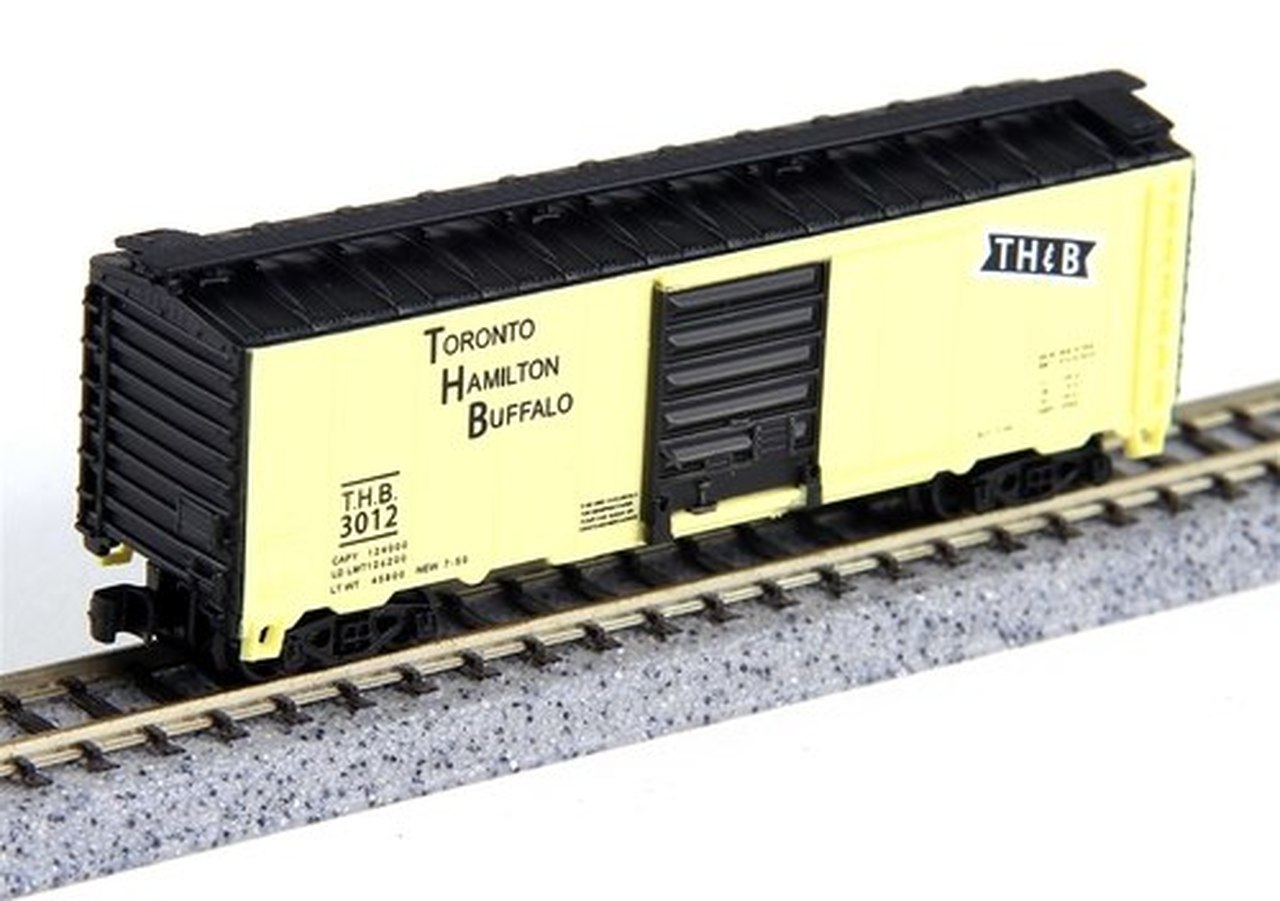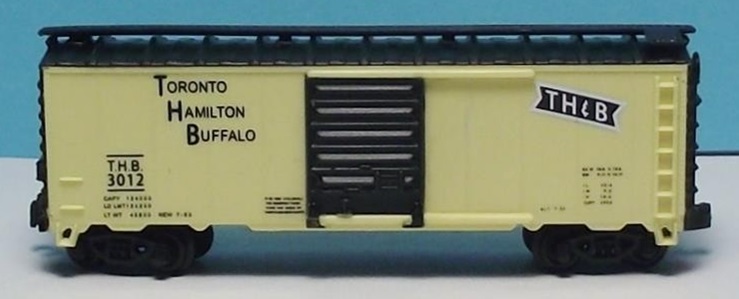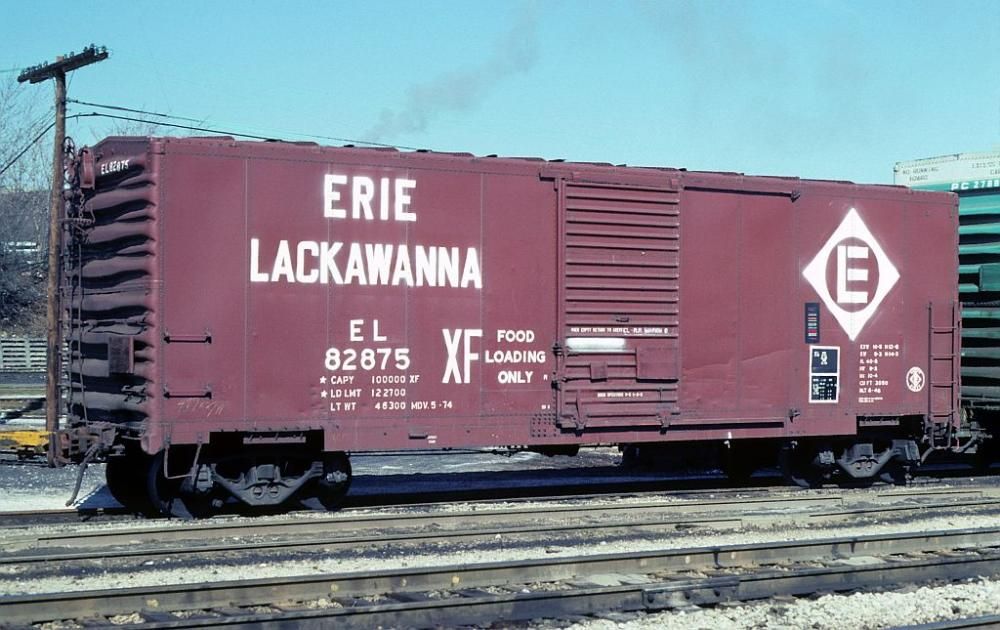Specific Item Information: This item has been re-run later under same reference with a new Model Power mold.
Model Information: Mehano first produced this car for MRC. It is a direct knock-off of the Rivarossi-made steel boxcar, inspired from the PRR X-29 prototype. It purportedly designed by Atlas to replace the Rivarossi model (labor costs in Italy?), but Atlas never actually ordered any to be made once the design was completed by Mehano. I am not confident this is true as the oldest versions of this car that I have seen are stamped 'MRC Yugoslavia' which implies the mold was designed for MRC and not Atlas. It was later imported by Life-Like, Model Power and AHM. It carries nickel-silver plated wheels and Rapido couplers. It is a typical 1st gen rolling stock model with low-quality pad printing (at least for the older models) and a simple mold.
Model Power later re-ran their Mehano-made models in China, using the same roadnames and numbers and the same stock number. The main differences between the Mehano and the Chinese molds can be observed on the door and the sill of the underframe; the Mehano is also slightly lower in height. The best way to distinguish them remains however the marking on the under-frame (Yugoslavia or Hong-Kong)
Model Power later re-ran their Mehano-made models in China, using the same roadnames and numbers and the same stock number. The main differences between the Mehano and the Chinese molds can be observed on the door and the sill of the underframe; the Mehano is also slightly lower in height. The best way to distinguish them remains however the marking on the under-frame (Yugoslavia or Hong-Kong)
Prototype History: Steel boxcars became a common site in the post-WWII period (also known as the transition era). Steel construction resulted in a lighter, lower-maintenance car that was less expensive to acquire and operate. The economies of scale that happened during the war along with a cessation of orders from the military resulted in a plentiful, inexpensive source of metal and aluminum for the railcar manufacturers which in turn led a complete replacement of the aging wood-sheathed fleets with new steel cars.
Road Name History: The TH&B was chartered in 1884 to connect Hamilton, Ontario to Fort Erie, just across the border from Buffalo, New York. However, once construction commenced, the goals changed. Ultimately, the TH&B would run from Waterford east to Hamilton and Welland, Ontario. Two branches ran south from this line to reach the lake port cities of Port Cleburn and Port Maitland (both on Lake Erie.) Until 1932, TH&B ran a car ferry operation between Port Maitland and Ashtabula, Ohio. In total, the TH&B was 111 miles long, making it slightly shorter that Richmond Fredricksburg & Potomac. In 1895 ownership was split between Canadian Pacific and three of the New York Central Lines: Michigan Central, Canada Southern and New York Central. TH&B was an important carrier for heavy industries in the Hamilton, Ontario area.
The most modern steam power on the TH&B was a pair of 2-8-4 Berkshires (the only Berkshires on a Canadian railroad) and a pair of 4-6-4 Hudsons. Strangely, none of TH&B’s steamers were equipped with all-weather cabs which were so common in Canada. This may have been due to the influence of NYC’s mechanical department.
TH&B had completely dieselized by 1954: NW2: 4, SW9: 4, GP7: 7, GP9: 3. The three GP9’s were built with boilers for passenger service and with their air tanks mounted on the roof. The GP9’s were also built to run long-hood-forward unlike the GP7’s. This often led to consists that appeared to have the locomotives “elephant walking” when in fact they were running back to back. One of the GP7’s was destroyed in a wreck in 1980. The roster then remained the same until the end. They also never really changed their paint scheme (except for adding the logo to the cab side around 1970.)
New York Central’s share of TH&B passed to Penn Central in that merger. After the collapse of PC and the creation of Conrail, CP Rail picked up PC’s share of the TH&B in 1977. However, TH&B remained a separate railroad for another 10 years until being merged into CPR.
The most modern steam power on the TH&B was a pair of 2-8-4 Berkshires (the only Berkshires on a Canadian railroad) and a pair of 4-6-4 Hudsons. Strangely, none of TH&B’s steamers were equipped with all-weather cabs which were so common in Canada. This may have been due to the influence of NYC’s mechanical department.
TH&B had completely dieselized by 1954: NW2: 4, SW9: 4, GP7: 7, GP9: 3. The three GP9’s were built with boilers for passenger service and with their air tanks mounted on the roof. The GP9’s were also built to run long-hood-forward unlike the GP7’s. This often led to consists that appeared to have the locomotives “elephant walking” when in fact they were running back to back. One of the GP7’s was destroyed in a wreck in 1980. The roster then remained the same until the end. They also never really changed their paint scheme (except for adding the logo to the cab side around 1970.)
New York Central’s share of TH&B passed to Penn Central in that merger. After the collapse of PC and the creation of Conrail, CP Rail picked up PC’s share of the TH&B in 1977. However, TH&B remained a separate railroad for another 10 years until being merged into CPR.
Brand/Importer Information: Founded in the late 1960's by Michael Tager, the 3rd generation business specializes in quality hobby products serving the toy and hobby markets worldwide. During its 50 years of operation, Model Power has developed a full line of model railroading products, die-cast metal aircraft, and die-cast metal cars and trucks.
In early 2014, Model Power ceased its business operations. Its extensive portfolio of intellectual property and physical assets are now exclusively produced, marketed, sold, and distributed by MRC (Model Power, MetalTrain and Mantua) and by Daron (Postage Stamp Airplanes and Airliner Collection).
In early 2014, Model Power ceased its business operations. Its extensive portfolio of intellectual property and physical assets are now exclusively produced, marketed, sold, and distributed by MRC (Model Power, MetalTrain and Mantua) and by Daron (Postage Stamp Airplanes and Airliner Collection).
Manufacturer Information: Mehano is a Slovenian toy manufacturer located in Izola, Slovenija. The company was founded as Mehanotehnika and was producing toys starting in June 1953. They first exhibited at the Nuerenberg Toy Fair in 1959. Mehano produced a number of different locomotives and rolling stock models for the North American market in the 1960s and 1970s. Companies such as Atlas and Life-Like imported a huge variety of their products. Generally they can easily be recognized as they are stamped "Yugosolavia" on the underframe. The company was formally renamed "Mehano" in 1990. Izola today is part of the country of Slovenia since the breakup of Yugoslavia.
Mehano filed for bankruptcy in 2008, but still continued to exist and operate. Since 2012, Mehano products are distributed by Lemke.
Mehano filed for bankruptcy in 2008, but still continued to exist and operate. Since 2012, Mehano products are distributed by Lemke.
Item created by: Jenna on 2019-05-16 16:40:20. Last edited by gdm on 2022-11-01 11:05:39
If you see errors or missing data in this entry, please feel free to log in and edit it. Anyone with a Gmail account can log in instantly.
If you see errors or missing data in this entry, please feel free to log in and edit it. Anyone with a Gmail account can log in instantly.













